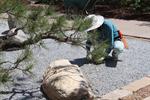SAVE THE BACK, USE THE HEAD!
HARD WORK SOLUTIONS
 Some jobs around the home (inside & out) are simply a lot harder than others. They might be back breaking, or simply awkward, such as: lifting heavy things, earthworks for a new garden, removing a large tree root/stump, or moving a large object in the house (without damaging the house.
Some jobs around the home (inside & out) are simply a lot harder than others. They might be back breaking, or simply awkward, such as: lifting heavy things, earthworks for a new garden, removing a large tree root/stump, or moving a large object in the house (without damaging the house.
Manually Lifting Objects
Poor lifting technique is probably the biggest single cause of back injuries at home or work. Where possible use alternative ways of moving objects, such as a trolley, or a wheel barrow, or for very heavy items use a forklift, lifting devices on tractors, or perhaps a bobcat if these are available. If you intend to manually handle the object, however, then try and practice the following good lifting habits:
- Test the weight of any thing you are going to lift carefully. Simply pushing it, or tipping it a little will help give you a “feel” for how heavy it is.
- Avoid twisting or jerking while lifting or carrying anything, or you might injure the joints which help guide movement in the back.
- Avoid leaning forward when lifting to minimise stress on the spine. Injuries most commonly occur when you lean forward and twist at the same time.
- Know your limitations & don’t push it…you may suffer for life.
- Always warm up & stretch before lifting.
- Use gloves to minimise the likelihood of hurting hands from splinters, sharp edges, etc, and to give you greater grip on slippery surfaces. Good grip is also important for foot wear.
- Whenever possible get help lifting, particularly if objects are heavy, large, or difficult to get a grip on or hold. While many hands make light work, it is important to make sure all hands move in the same direction. Talk first, get a plan, then work together.
- Before you lift make sure you have a clear path with plenty of width, nothing to trip over or bump into, and check that floor surfaces aren’t slippery.
- Items that might be readily damaged if they are bumped against other things can be protected by wrapping them in a blanket or something similar.
How To Lift
- Stand close to the object you wish to lift, but not too close that you are crowded.
- Place your feet shoulder width apart.
- Bend down towards the object from the hips and knees.
- Take hold of the object carefully, making sure that you have a good grip.
- Use your leg muscles to lift your body and the object upwards.
- Keep your back as straight as you can at all times while doing the lift, and subsequently moving the object.
- Lowering the object should be the reverse of the lifting technique.

Other Ways Of Lifting
- The wheel (one of mans first inventions, and still one of the best). Trolleys, pulleys, wheelbarrows, or low boards on strong wheels (fridge trolleys) can be moved under items to be lifted, or used to transport items from place to place once you have manually lifted them, to greatly reduce the effort, and the stress on your body required in shifting them. Such tools can often be moved beneath heavy objects by carefully rocking the object onto its edge, moving the trolley, etc. under it, and then lowering the object back down.
- Leverage can be easily applied to heavy objects to either raise them enough to move a trolley or something similar beneath them, or to actually move the object short distances using tools such as crow bars.
- Ropes can be used to drag or lift items by such means as a simple pulley system, or by towing the item behind a vehicle, or hand towed when the object is on wheels or rollers. Be sure the rope/s are securely attached, and off sufficient strength, particularly when objects are being lifted up off the surface. Also make sure that what you are hanging the ropes from, or attaching them too, has sufficient strength to hold the weight of the object.
Using Machines To Do The Heavy Work
There are a wide variety of machines available to do the heavy work for you. You must consider, however:
- Their cost to hire or buy – will you get enough use out of them to justify the purchase or hire, plus any ongoing costs such as maintenance?
- Is there sufficient room in your garden, house, etc. for the machine to operate?
- Do you have the expertise, and if necessary, valid licences to use the equipment?
Machines are commonly used in domestic situations for earthworks (small & large), chopping up wood, stump eaters, and wood chippers.
Earthworks
Small earth moving jobs in easy to dig soils can be readily done with a wheelbarrow and shovel. Most small jobs though, will benefit from additional rotary hoeing to loosen the soil (especially clay soils). It will then be easier to work the soil with a shovel.
A ROTARY HOE
These are used to turn over soil, cultivating it using a series of rotating blades. They can range in size from small tillers for regular domestic use, to larger self propelled machines for larger work such as the initial cultivation at a new house site, to tractor driven models for heavier, deeper work, and for larger areas. The larger self propelled units can often be hired for a reasonable cost and generally don’t require a licence to operate. A solid days work with one can save you a great deal of work later on by hand, in both digging and weed control.
Medium to large jobs (anything requiring movement of more than a couple of cubic metres of soil) will benefit from the use of some type of earth moving machinery. These include:
A CAT
A small machine with rubber tyres and a tractor bucket on the front. The bucket can lift and carry loose soil, rocks, sand, etc. It can dig in soil to some extent, but not as much as some other machines. It is more likely to get bogged in wet or loose soil than a backhoe or dozer. Being the smallest, and often the cheapest to hire, a cat is most appropriate in confined spaces around a house on a small block (often it is the only machine small enough to gain access to the backyard).
A BACKHOE
Larger than a cat, with a bucket on the front and a digging scoop on a movable arm at the back. It can do everything that a cat can do, and more. It is better at digging, it can dig trenches for pipes or foundations and can place rocks easier and more precisely than a cat or dozer. It has rubber tyres like a cat and can easily get bogged particularly in wet soil, but can use its digging arm to pull itself out.
A DOZER
Moves on "tracks" (like an army tank) rather than rubber wheels. It is not prone to getting bogged like a backhoe or cat. Is able to work on steeper slopes than wheeled machines. Has a bucket or blade on the front. Good for digging and shaping the ground, but not always good for moving materials or for trenching. It is not suitable for small areas, although in recent years a range of mini-dozers, have become available, which are more suitable for small areas.
AN EXPERIENCED OPERATOR MAKES ALL THE DIFFERENCE!
When you hire a machine, hire it with a driver who is experienced. A good driver will do three times as much work in the same period of time. Generally half a day should get most of the earth moving and other heavy work done in an average new home garden. This might involve:
- Some cut and fill work to terrace a part of the garden.
- Establishing the basic levels for the lawn areas.
- Bringing soil and mulch from where it was delivered at the front and dumping it in different parts of the garden where it will later be used.
- Placing large boulders in position where they might be later used.
Ask a few different contractors for references from past clients, and talk with people who used them before deciding who to use. Doing this could save you hundreds of dollars on your earth moving bill.
EBOOKS by our John Mason (Principal)
More from ACS
Ebook - Advice from professional horticulturists with decades in the industry.
View eBook
Ebook - Over 60,000 copies sold: a classic reference.
View eBook
Ebook - Decide what you can produce in your garden and the growing conditions needed for a range of climates.
View eBook
Ebook - a great informative text to extend your knowledge and get it right the first time!
View eBook
Course - The opportunities for green walls and roofs will only increase as our cities continue to grow.
This is a solution to environmental and commercial problems on so many levels.
View Course
Course - Horticultural therapists use horticultural activities as a tool for helping disadvantaged people.
View Course
Course - For professonal gardeners, those setting up a business or the home gardener.
View Course